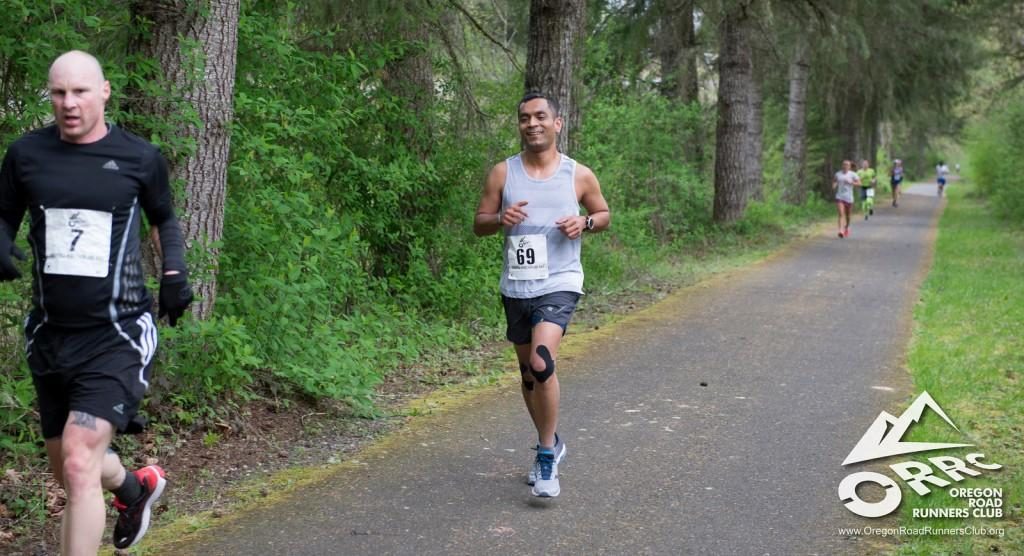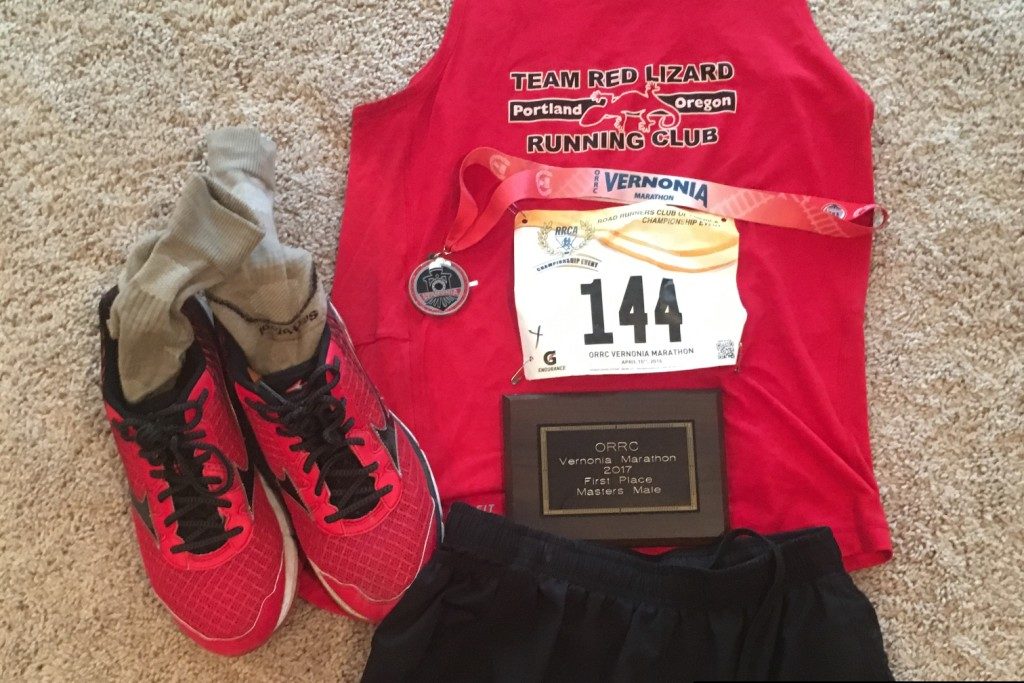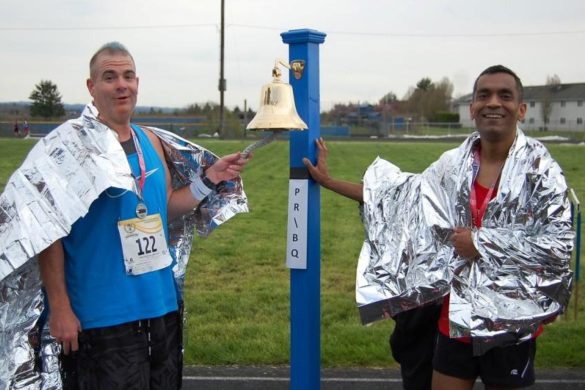Part 3
A marathon before you’re 40 is impressive, but isn’t it more impressive to run one after 40?
My experience at the Portland Marathon was so poor, I initially resolved to never run another marathon. However, by the beginning of 2016, that experience was a distant but embarrassing memory, and I was eager to erase it with a better effort. I found a training plan in the Nike+ app that seemed reasonable. My friend Conor and I decided to join forces in marathon prep, and we used the Nike+ plan fairly religiously. Conor introduced me to the wonders of interval training, and we added 800m intervals after reading a Runner’s World article on Yasso 800s.
During the course of marathon prep, I signed up for 7 half-marathons and a 30k race, each one taking the place of the long run for the week. Three of the half-marathons resulted in personal records, which greatly boosted my confidence in my training. The last of these was the Hop Hop Half Marathon, which I finished in 1:36:22, for my first finish under 7:30 min/mi (4:35 min/km).

On the course at the Vernonia-Banks Marathon, 2016. By this time I’d learned the virtues of dressing for the middle of the race, not the start.
In April, I lined up to start my 3rd marathon, the Vernonia-Banks Marathon. The Vernonia-Banks Marathon is a point-to-point race organized by the Oregon Road Runners’ Club, who bus runners to the start in Vernonia, from where they run to the finish in Banks. By this time, I knew not to overdress, and was in a singlet and shorts. I started out at a reasonable pace, targeting a finish of around 3:20, and was able to maintain it through mile 21. Despite bonking at mile 21, and having my pace deteriorate by about a minute per mile, I was able to better my marathon time to 3:24:31. (Unfortunately, Conor was injured at mile 23 and couldn’t finish the race, but I hope to drag him across a marathon finish at a future date.)
You’re a Lizard, Harry!

I’m usually too sweaty and tired after races, so I just take a picture of the medal, shoes, and bib. In this case, I had a bonus plaque.
At the beginning of 2016, I also joined a running club, Team Red Lizard (TRL), and started attending a weekly group run after the Vernonia-Banks Marathon. TRL is full of extremely talented and dedicated runners, very keen on running and having fun, some of which involves food and beer. They have been an excellent group to make new friends and get inspiration and training tips. TRL also provides pacers for the Portland Marathon, and I was part of the team of pacers for the 2016 Portland Marathon, where I ran the first half at an 8:00 min/mile pace to help other runners stay on pace target. What was also gratifying was that the fitness gained from a consistent training plan and regular training inputs from the Lizards allowed me to improve my half-marathon time to 1:31:37 at the 2016 Oregon Summer Half.
Prepping for an even better marathon.
With the help of friends in TRL, including the club’s running coach (Rick Lovett), and a book on marathon training (Pfitzinger), I prepared for the 2017 Vernonia-Banks Marathon with a goal time of 3:12, 3 minutes under the qualification threshold for Boston 2018. For 12 weeks starting in early January, I would wake typically between 4:30 and 5am and run between 5 and 20 miles, 5 days a week, sometimes by myself, and sometimes with friends — snow, rain, or shine, though I should note there is very little shine in Portland during winter.
Although I couldn’t attend TRL’s Tuesday track workouts, I was able to use Rick’s workout archive on the TRL website to pick from a large variety of weekly interval workouts, many of which Conor gamely joined in. On long runs, friends would join me halfway through the run to keep me going as I completed 16-22 miles along Portland’s waterfront. On some days I ran twice to meet my weekly mileage goal of 50-60 miles. As in 2016, I picked half marathon and 30k races to run as some of my long runs, and ran an extra 3-6 miles after the race to reach the mileage goal for the day. This made the long runs a lot more fun.

Being passed by a much-faster Tim Murphy, at the appropriately named BATH TIME 2017. I tried to indicate my displeasure at his being faster than me non-verbally, but he didn’t get it.
One of the most insane races I ran during this time was Bill Aronson’s Track Half To Insure Mileage Exactness (BATH TIME), which is a half-marathon on a track, in February. Bill has a talent for arranging for terrible weather at this event, and as usual, it featured a heavy February downpour, and a very competitive field (Peter Bromka won in 1:11:58). Bill noted later with a twinge of disappointment that it wasn’t as bad as previous years since there were no gale-force winds. It is as nutty as it sounds, so if I’m invited back, I’ll probably run this again.
I knew my training was on the right track when I got a half-marathon personal record of 1:30:08 at the 2017 Vancouver Lake Half in the middle of marathon training, and when my 800 meter intervals started hitting 3:05 due to a correlation between 800 meter intervals and marathon finish times; Yasso 800s are a predictor workout for marathons but tend to predict an optimistic time. (I have since improved my half-marathon time to 1:29:41 at the 2017 Oregon Summer Half, and then 1:29:14 at the ORRC Blue Lake Half.)

Running the 10k race at the ORRC Dual Duel, 2016. I wasn’t especially fast at this track-10k-race due to the heat, but managed to overtake the guy in green on the last lap (he had passed me earlier in the race) to get second place in a small field.
The most difficult part of training was giving up caffeine! A caffeine-fast is a way to make the race-morning coffee extra-effective, but it is not for the faint of heart. I started my caffeine-fast about two weeks prior to the marathon, and for 4 or 5 days I was an irritable mess. By day 3, if it weren’t for the thought of the race-day caffeine jolt, I would’ve snorted instant coffee. And do not be fooled. Mint tea is not a substitute. You might as well eat toothpaste-soup and hope to get a caffeine fix.
Beet juice and Thai green chilis?
On April 9, I lined up at the Vernonia-Banks Marathon start line for the second time. I knew that my training had been a lot more thorough than the previous year. I had a caffeine pill an hour prior to the race, and downed beet juice concentrate, the latter due to a research paper extolling the effects of dietary nitrates on race performance.
I had told myself Vernonia-Banks would be a fun, easy course because it would have a downhill section in the third quarter of the race. At the last minute, I revised my goal downward to 3:07 (3 hours and 7 minutes), feeling overconfident in my training, and took off ready for the BQ.
I had forgotten that the second quarter was uphill. The extra effort in the first half meant that by the time the third quarter started, I was tired and winded. Instead of accelerating through the downhill, I ended up using the downhill to recover my breath for the flat finish in the fourth quarter. (Rick later noted to me that any decision made within 24 hours of a marathon is a mistake, other than obvious things like adjusting to unexpected weather.)
At mile 18, the first cramps hit. I bit down on a Thai green chili, hoping an article I’d read on hot peppers alleviating cramps would prove to be true. It did, but some of the chili fumes went into my eyes and nose. After blinking away tears, I was able to push through to mile 23 … a little over 3 miles to go. I’ve run this distance countless times, but those were the toughest 5 km I ever ran. Head tilted back to get as much air in me as possible, but feeling light-headed and knowing that if I paused for even a little bit, I would faint and/or cramp and wouldn’t be able to restart, I kept telling myself to push through the last few miles. I started slowing down as I was running on fumes (chili fumes!), and adjusted goals from 3:07 to 3:08 to 3:09 and told myself to just meet the BQ target.
Finally, I saw the finish line but I had to complete a 400 meter loop around the Banks High School track to cross it. I crossed the finish line at 3:11:43, and rang the bell meant for Boston Qualifiers. Teammates from my Hood-to-Coast team, who’d run the half-marathon, were waiting at the finish, cheering, and taking pictures. One of them texted my wife with the news, and she and other friends who were following the results online posted them on Facebook — first place masters, fifth overall, and — most importantly — BQ!
I later heard someone say that the first half of a marathon is 20 miles.
The 2018 Boston Marathon cutoff was 3:23 min below the qualification mark of 3 hours and 15 min. At 3 min 17 seconds below the qualification time, my entry to the 2018 Boston Marathon was not accepted.



